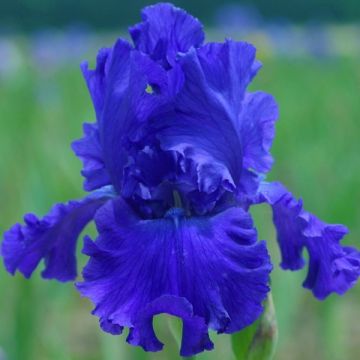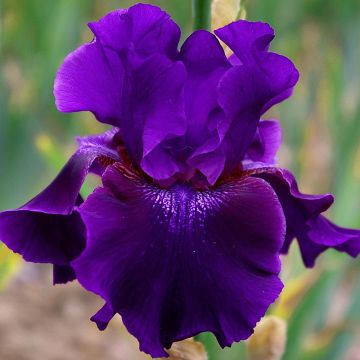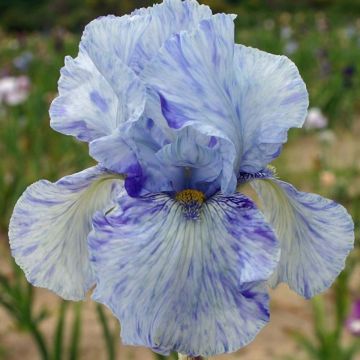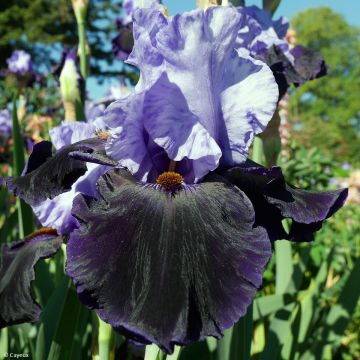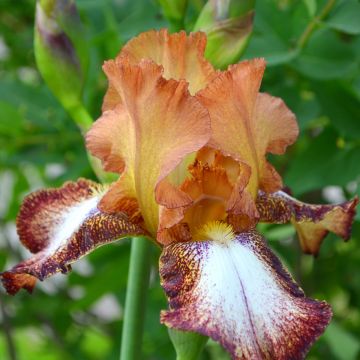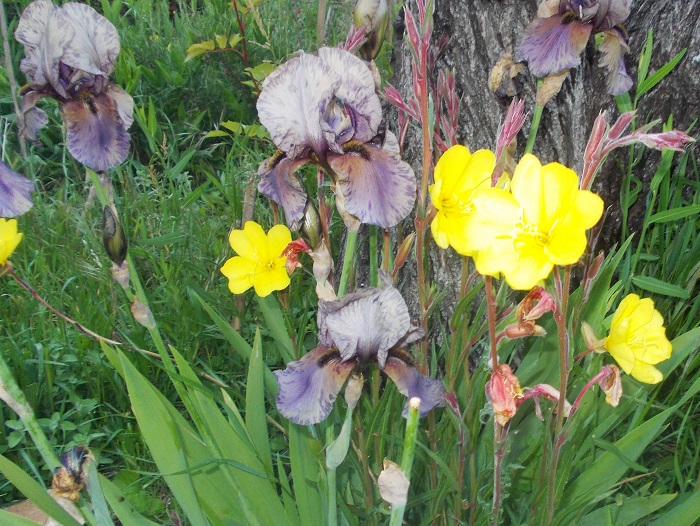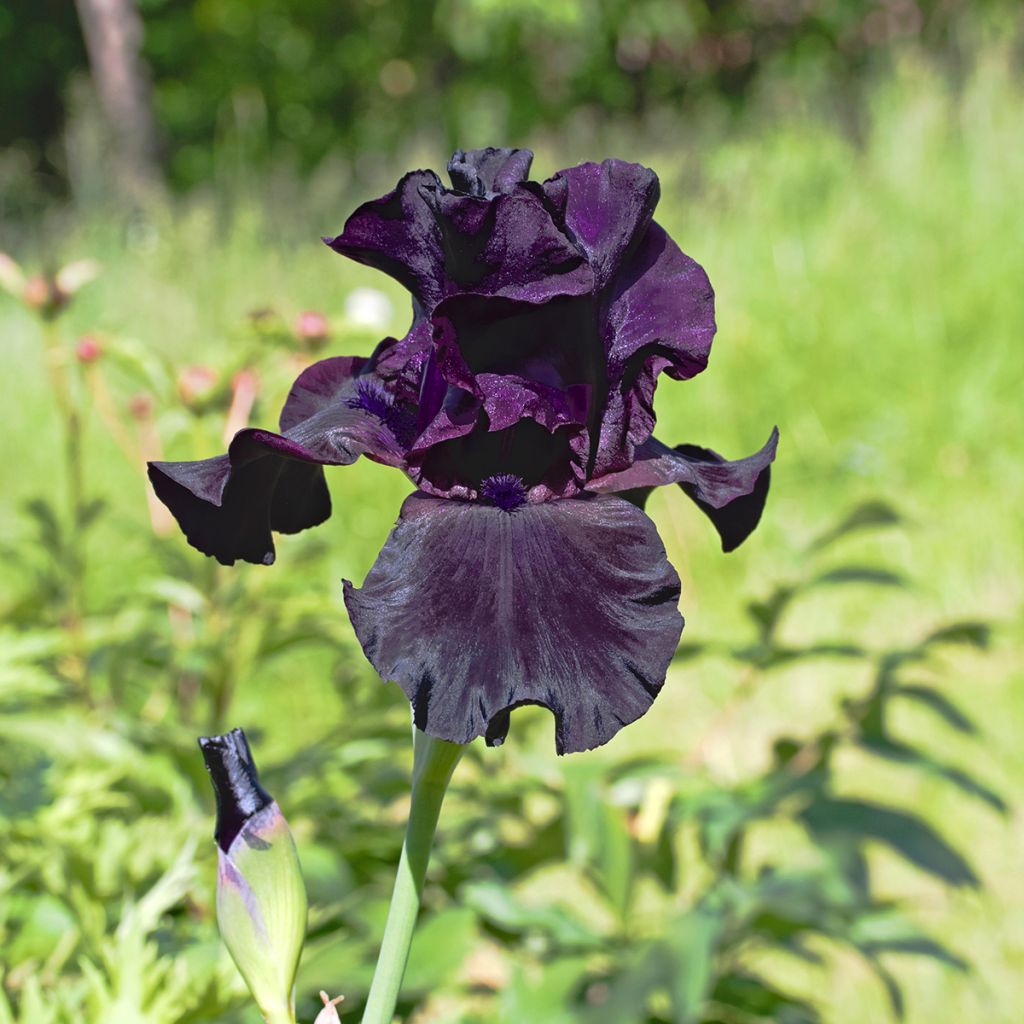

Iris germanica Black Suited - Bearded Iris
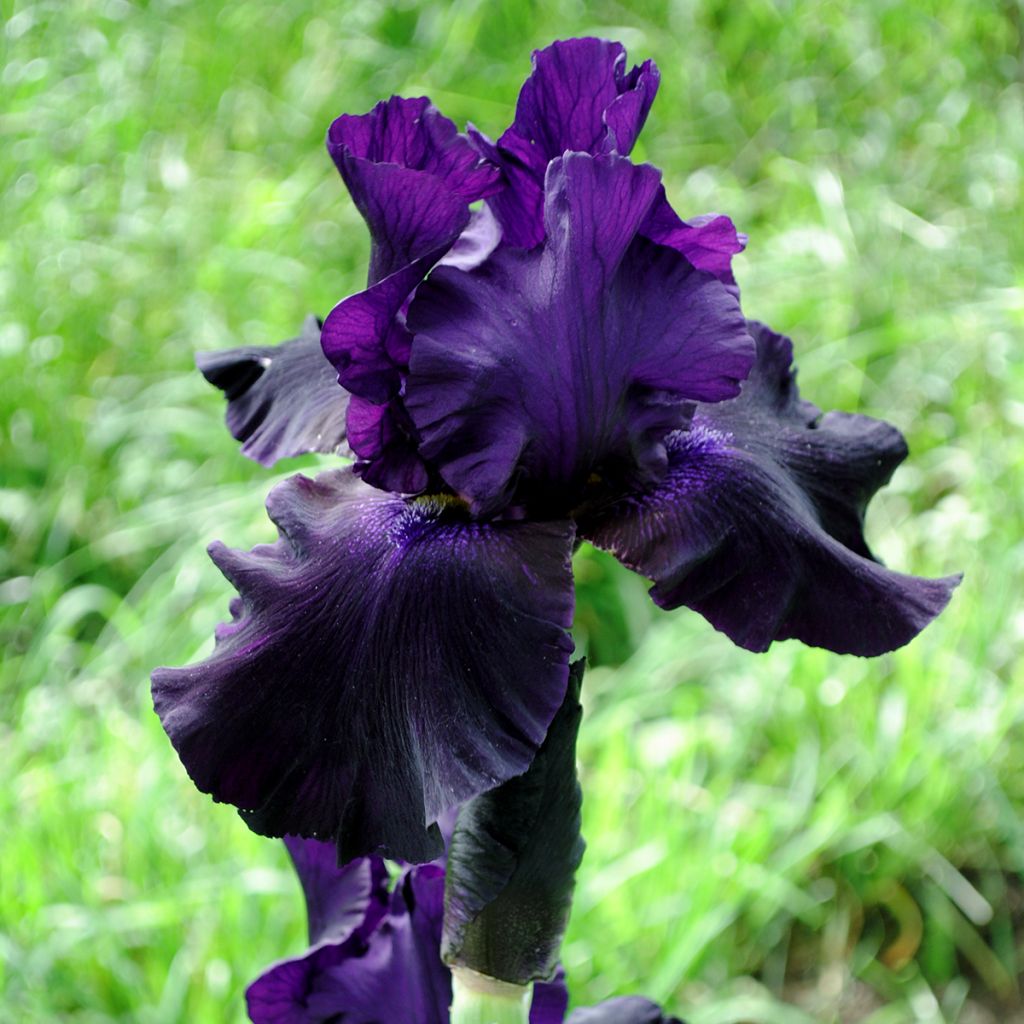

Iris germanica Black Suited - Bearded Iris
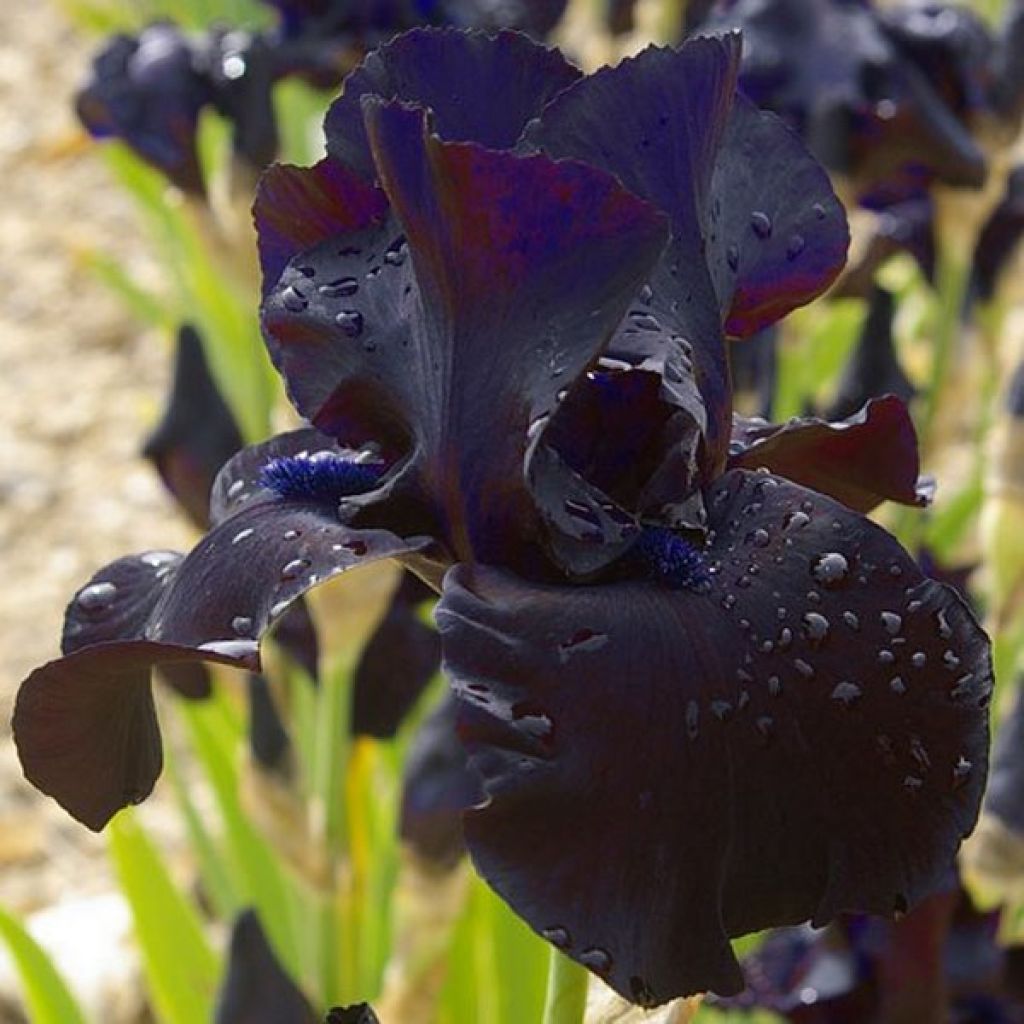

Iris germanica Black Suited - Bearded Iris
Iris germanica Black Suited - Bearded Iris
Iris germanica Black Suited
German Iris, Bearded Iris
Special offer!
Receive a €20 voucher for any order over €90 (excluding delivery costs, credit notes, and plastic-free options)!
1- Add your favorite plants to your cart.
2- Once you have reached €90, confirm your order (you can even choose the delivery date!).
3- As soon as your order is shipped, you will receive an email containing your voucher code, valid for 3 months (90 days).
Your voucher is unique and can only be used once, for any order with a minimum value of €20, excluding delivery costs.
Can be combined with other current offers, non-divisible and non-refundable.
Home or relay delivery (depending on size and destination)
Schedule delivery date,
and select date in basket
This plant carries a 12 months recovery warranty
More information
We guarantee the quality of our plants for a full growing cycle, and will replace at our expense any plant that fails to recover under normal climatic and planting conditions.

Does this plant fit my garden?
Set up your Plantfit profile →
Description
Iris germanica Black Suited is not only one of the blackest in its category, but this variety is also prolific and fragrant. Its flowers have black and beautifully undulated petals and sepals, with some violet infusions at the base, as well as an extremely dark blue-violet beard. It is an especially vigorous and floriferous iris, rare qualities among black irises.
The 'Black Suited' Iris is a rhizomatous perennial plant that grows in elegant clumps from spring, with its foliage disappearing in winter. It belongs to the Iridaceae family. It is one of the many cultivars obtained over centuries, with a controversial origin that revolves around the number of chromosomes of potential ancestors. Garden Irises have European origins. They are plants that thrive in limestone soils and crave sunlight, with rhizomes that need to 'cook' in summer to be able to bloom. A minimum of 6 hours of sunlight per day is generally required.
'Black Suited' will reach 90 cm (35in) in height when in bloom, with at least 6 to 8 buds per stem. The clump will spread indefinitely over time, with the central rhizomes thinning out in favour of the outer rhizomes. The foliage consists of long and wide saber-shaped leaves, with a slightly glaucous green colour, traversed by parallel veins. In April, floral stems appear with flowers in May-June that bloom from the top to the lower branches. The colour of the flowers is, as always with garden irises, magnified by the silky texture of the 3 upright petals and 3 drooping sepals. Note that the flower emits a very pleasant musky scent. It is a mid to late-season variety.
Obtained by Sterling Innerst.
Award: Award of Merit (AM) in 2003.
To accompany irises, choose plants to associate with them based on their needs (exposure, soil...) and that have vegetation that will not cast shade on the irises (low plants or plants with light foliage). For example, Gaura will cast little shade on the irises and will keep the iris bed attractive throughout the summer. California poppies will tolerate dry soil like irises. Perennial geraniums, herbaceous salvias, and Libertia also go well with irises. Slopes can be stabilized by dense plantings of old, sturdy varieties that require very little care. Medium height irises are less likely than tall irises to be knocked down by wind and rain. Plant iris clumps in small groups or individually among other plants and bushes that will take over after their spring flowering.
At the base of a wall, sheltered from the wind, tall irises can be planted. Of course, you can also plant shorter and early varieties in the foreground.
Path border: the entire range can be used, from early dwarfs under 40 cm (16in) to tall irises over 75 cm (30in) that bloom in May, including intermediates (in size and earliness) and border irises, which are medium-sized but bloom with the tall ones. Tall irises, exposed to strong winds, may need staking to prevent them from being knocked over.
Border of flower bed: the home of border irises... but also dwarfs, depending on the circumstances.
Mixed border: the entire range of sizes can be used, chosen according to the position (front, back) and the size of the surrounding plants.
Using the full range of garden irises allows for two and a half months of spring flowers. Reblooming irises offer a few more flowers in late summer or autumn, depending on the climate.
The vegetable garden can be adorned with a few clumps or borders of irises for cutting.
Iris germanica Black Suited - Bearded Iris in pictures
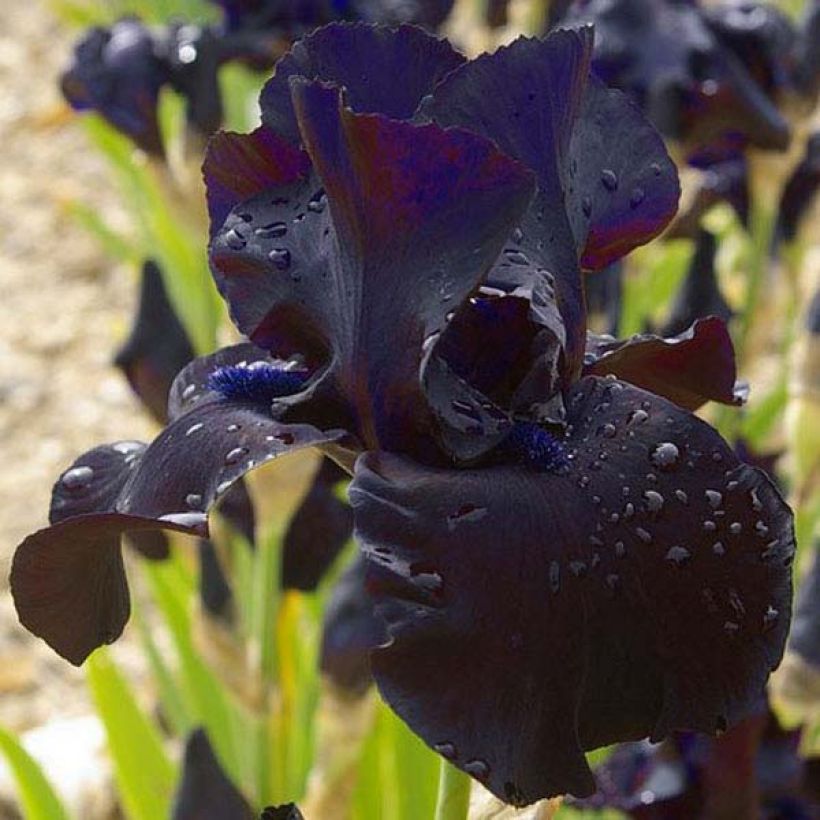

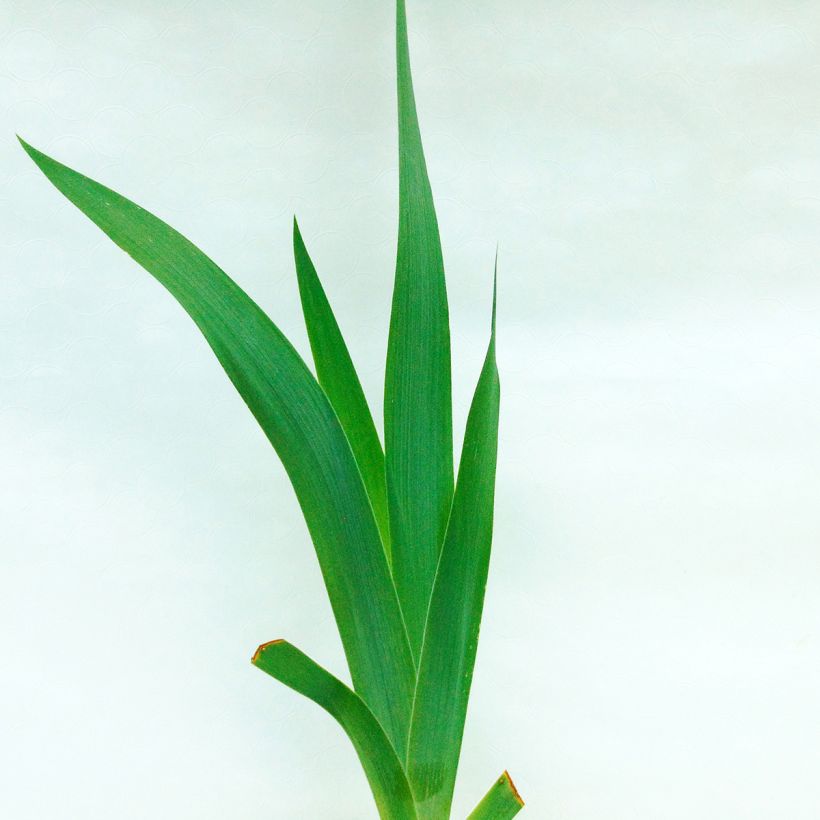

Flowering
Foliage
Plant habit
Botanical data
Iris
germanica
Black Suited
Iridaceae
German Iris, Bearded Iris
Cultivar or hybrid
Other German Iris - Bearded Iris
View all →Planting and care
Iris Black Suited should be planted shallowly, leaving the rootstock exposed at ground level. Add sand when the soil is too heavy or too wet and place the rootstocks on small mounds. Ensure good drainage so that the irises do not rot. These irises prefer alkaline soils: amend your soil with lime if it is acidic. In summer, this iris should be watered 1 to 2 times a month. At the end of flowering, they should be pruned by cutting the flower stalks to 10 cm (4in) from the ground. Damaged leaves should only be removed in autumn. It is not recommended to provide too much nitrogen as it weakens the plant and increases the number of leaves at the expense of flowers. As they grow taller, the flower stems become brittle. Irises can be susceptible to heterosporiosis, a disease characterized by oval brown spots. T Every 4 years in summer after flowering, divide the clumps by pulling up the entire plant. Transplantation should be done in a location without irises for one year. Take the most beautiful young plants from the rootstock, usually those on the outer edge.
Planting period
Intended location
Care
Planting & care advice
-
, onOrder confirmed
Reply from on Promesse de fleurs
Haven't found what you were looking for?
Hardiness is the lowest winter temperature a plant can endure without suffering serious damage or even dying. However, hardiness is affected by location (a sheltered area, such as a patio), protection (winter cover) and soil type (hardiness is improved by well-drained soil).

Photo Sharing Terms & Conditions
In order to encourage gardeners to interact and share their experiences, Promesse de fleurs offers various media enabling content to be uploaded onto its Site - in particular via the ‘Photo sharing’ module.
The User agrees to refrain from:
- Posting any content that is illegal, prejudicial, insulting, racist, inciteful to hatred, revisionist, contrary to public decency, that infringes on privacy or on the privacy rights of third parties, in particular the publicity rights of persons and goods, intellectual property rights, or the right to privacy.
- Submitting content on behalf of a third party;
- Impersonate the identity of a third party and/or publish any personal information about a third party;
In general, the User undertakes to refrain from any unethical behaviour.
All Content (in particular text, comments, files, images, photos, videos, creative works, etc.), which may be subject to property or intellectual property rights, image or other private rights, shall remain the property of the User, subject to the limited rights granted by the terms of the licence granted by Promesse de fleurs as stated below. Users are at liberty to publish or not to publish such Content on the Site, notably via the ‘Photo Sharing’ facility, and accept that this Content shall be made public and freely accessible, notably on the Internet.
Users further acknowledge, undertake to have ,and guarantee that they hold all necessary rights and permissions to publish such material on the Site, in particular with regard to the legislation in force pertaining to any privacy, property, intellectual property, image, or contractual rights, or rights of any other nature. By publishing such Content on the Site, Users acknowledge accepting full liability as publishers of the Content within the meaning of the law, and grant Promesse de fleurs, free of charge, an inclusive, worldwide licence for the said Content for the entire duration of its publication, including all reproduction, representation, up/downloading, displaying, performing, transmission, and storage rights.
Users also grant permission for their name to be linked to the Content and accept that this link may not always be made available.
By engaging in posting material, Users consent to their Content becoming automatically accessible on the Internet, in particular on other sites and/or blogs and/or web pages of the Promesse de fleurs site, including in particular social pages and the Promesse de fleurs catalogue.
Users may secure the removal of entrusted content free of charge by issuing a simple request via our contact form.
The flowering period indicated on our website applies to countries and regions located in USDA zone 8 (France, the United Kingdom, Ireland, the Netherlands, etc.)
It will vary according to where you live:
- In zones 9 to 10 (Italy, Spain, Greece, etc.), flowering will occur about 2 to 4 weeks earlier.
- In zones 6 to 7 (Germany, Poland, Slovenia, and lower mountainous regions), flowering will be delayed by 2 to 3 weeks.
- In zone 5 (Central Europe, Scandinavia), blooming will be delayed by 3 to 5 weeks.
In temperate climates, pruning of spring-flowering shrubs (forsythia, spireas, etc.) should be done just after flowering.
Pruning of summer-flowering shrubs (Indian Lilac, Perovskia, etc.) can be done in winter or spring.
In cold regions as well as with frost-sensitive plants, avoid pruning too early when severe frosts may still occur.
The planting period indicated on our website applies to countries and regions located in USDA zone 8 (France, United Kingdom, Ireland, Netherlands).
It will vary according to where you live:
- In Mediterranean zones (Marseille, Madrid, Milan, etc.), autumn and winter are the best planting periods.
- In continental zones (Strasbourg, Munich, Vienna, etc.), delay planting by 2 to 3 weeks in spring and bring it forward by 2 to 4 weeks in autumn.
- In mountainous regions (the Alps, Pyrenees, Carpathians, etc.), it is best to plant in late spring (May-June) or late summer (August-September).
The harvesting period indicated on our website applies to countries and regions in USDA zone 8 (France, England, Ireland, the Netherlands).
In colder areas (Scandinavia, Poland, Austria...) fruit and vegetable harvests are likely to be delayed by 3-4 weeks.
In warmer areas (Italy, Spain, Greece, etc.), harvesting will probably take place earlier, depending on weather conditions.
The sowing periods indicated on our website apply to countries and regions within USDA Zone 8 (France, UK, Ireland, Netherlands).
In colder areas (Scandinavia, Poland, Austria...), delay any outdoor sowing by 3-4 weeks, or sow under glass.
In warmer climes (Italy, Spain, Greece, etc.), bring outdoor sowing forward by a few weeks.


































